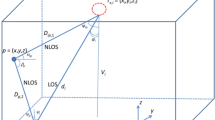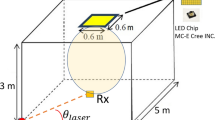Abstract
From last few years indoor localization has become more popular for wireless devices. The major reason for its popularity is to access current location efficiently. On the other side visible light communication is attaining interest of researchers due to high growth of wireless communication and solid state lighting. This network structure can produce high accuracy for the resident positioning electromagnetic environment. The proposed approach is viable for both air and underwater communication based on the visible light spectrum. We evaluate the technique for other supervised machine learning algorithms to analyse an accuracy, error distance and computational time for indoor localization in visible light communication network. Experimental work was made by using star topology supported by visible personal area network system based simulator, which corresponds an attribute of PHY and MAC layer for IEEE 802.15.7 standard designed for short range optical wireless communication. The evaluation was carried out for an accuracy, error distance and computational time. The results show that the suggested methodology achieves overall computational accuracy and deliver an acceptable location estimation error.







Similar content being viewed by others
References
Uysal, M., Capsoni, C., Ghassemlooy, Z., Boucouvalas, A. C., & Udvary, E. G. (Eds.). (2016). Optical wireless communications—an emerging technology. Cham: Springer.
Bilal, M. M., Bi, W., Jaleel, F., Luwen, Y., Sohail, M. N., Irshad, M., et al. (2019). Magnetic fluid-based photonic crystal fiber for temperature sensing. Optical Engineering, 58(7), 072008. https://doi.org/10.1117/1.OE.58.7.072008.
Shao, S., Khreishah, A., & Khalil, I. (2016). Joint link scheduling and brightness control for greening VLC-based indoor access networks. Journal of Optical Communications and Networking, 8(3), 148–161.
Ayyash, M., Elgala, H., Khreishah, A., Jungnickel, V., Little, T., Shao, S., et al. (2016). Coexistence of WiFi and LiFi toward 5G: Concepts, opportunities, and challenges. IEEE Communications Magazine, 54(2), 64–71.
Zhuang, Y., Hua, L., Qi, L., Yang, J., Cao, P., Cao, Y., et al. (2018). A survey of positioning systems using visible LED lights. IEEE Communications Surveys and Tutorials, 20(3), 1963–1988. https://doi.org/10.1109/comst.2018.2806558.
Irshad, M., Liu, W., Wang, L., Shah, S. B. H., Sohail, M. N., & Uba, M. M. (2018). Li-local: Green communication modulations for indoor localization. In Proceedings of the 2nd international conference on future networks and distributed systems–ICFNDS’18 (pp. 1–6). New York: ACM Press. https://doi.org/10.1145/3231053.3231118.
Armstrong, J. (2013). Visible light positioning: A roadmap for international standardization. IEEE Communications Magazine, 51(12), 68–73.
Zeng, Z., Fu, S., Zhang, H., Dong, Y., & Cheng, J. (2017). A survey of underwater optical wireless communications. IEEE Communications Surveys Tutorials, 19(1), 204–238.
Shen, C., Guo, Y., Sun, X., Liu, G., Ho, K. T., Ng, T. K., Alouini, M. S. & Ooi, B. S. (2017) Going beyond 10-meter, Gbit/s underwater optical wireless communication links based on visible lasers. In 2017 opto-electronics and communications conference (OECC) and photonics global conference (PGC), July 2017 (pp. 1–3).
Saeed, N., Celik, A., Al-Naffouri, T. Y., & Alouini, M.-S. (2018) Connectivity analysis of underwater optical wireless sensor networks: A graph theoretic approach. In Submitted to IEEE international conference on communication, (ICC), May 2018.
Sohail, N., Jiadong, R., Uba, M., Irshad, M., & Khan, A. (2018). Classification and cost benefit analysis of diabetes mellitus dominance. International Journal of Computer Science and Network Security, 18(10), 29–35.
Sohail, M. N., Jiadong, R., Uba, M. M., & Irshad, M. (2019). A comprehensive looks at data mining techniques contributing to medical data growth: A survey of researcher reviews (pp. 21–26). Singapore: Springer. https://doi.org/10.1007/978-981-10-8944-2_3.
Do, T.-H., & Yoo, M. (2016). An in-depth survey of visible light communication based positioning systems. Sensors, 16, 678.
Yinfan, X., Zhao, J., Shi, J., & Chi, N. (2016). Reversed three-dimensional visible light indoor positioning utilizing annular receivers with multi-photodiodes. Sensors, 16(8), 1254.
Alonso-González, I., Sánchez-Rodríguez, D., Ley-Bosch, C., & Quintana-Suárez, M. (2018). Discrete indoor three-dimensional localization system based on neural networks using visible light communication. Sensors, 18(4), 1040. https://doi.org/10.3390/s18041040.
Chvojka, P. (2015). Channel characteristics of visible light communications within dynamic indoor environment. Journal of Lightwave Technology, 33, 1719–1725.
Zhang, B., Wang, H., Xu, T., Zheng, L., & Yang, Q. (2016). Received signal strength-based underwater acoustic localization considering stratification effect. In OCEANS (pp. 1–8).
[Online]. Available https://math.stackexchange.com/questions/651077/is-standard-deviation-the-same-as-entropy. Accessed 26 March 2018.
Akhoundi, F., Minoofar, A., & Salehi, J. A. (2017). Underwater positioning system based on cellular underwater wireless optical CDMA networks. In 26th Wireless and Optical Communication Conference (WOCC). https://doi.org/10.1109/WOCC.2017.7928991
Kahn, M. (1997). Wireless infrared communications. Proceedings of the IEEE, 85(2), 265–298.
Author information
Authors and Affiliations
Corresponding author
Additional information
Publisher's Note
Springer Nature remains neutral with regard to jurisdictional claims in published maps and institutional affiliations.
Rights and permissions
About this article
Cite this article
Irshad, M., Liu, W., Wang, L. et al. Cogent Machine Learning Algorithm for Indoor and Underwater Localization Using Visible Light Spectrum. Wireless Pers Commun 116, 993–1008 (2021). https://doi.org/10.1007/s11277-019-06631-4
Published:
Issue Date:
DOI: https://doi.org/10.1007/s11277-019-06631-4




